Ross Verlag
From 1935 on, Arthür Hämmerer made photo portraits for the Ufa which were used for the popular Ross postcards. Hämmerer photographed mainly German and Austrian actors. During the war years, he worked for the Viennese studio Wien-Film.
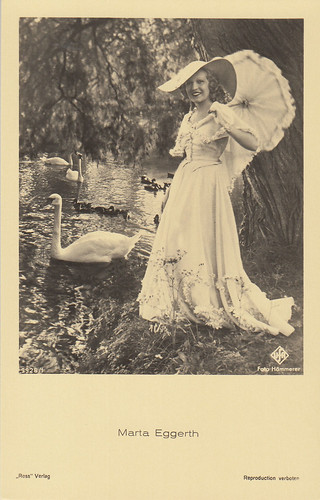
German postcard by Ross Verlag, no. 9928/1, 1935-1936. Photo: Hämmerer / Ufa. Marta Eggerth in Das Hofkonzert/The Court Concert (Detlev Sierck a.k.a. Douglas Sirk, 1936). Collection: Marlene Pilaete.
Hungarian-born singer and actress Márta Eggerth (1912-2013) maintained a global career for over 70 years. She was the popular and talented star of 30 German and Austrian operetta films of the 1930s. Many of the 20th century's most famous operetta composers, including Franz Lehár, Fritz Kreisler, Robert Stolz, Oscar Straus, and Paul Abraham, composed works especially for her. After the rise of the Nazis, she continued her career with her partner Jan Kiepura in the US.
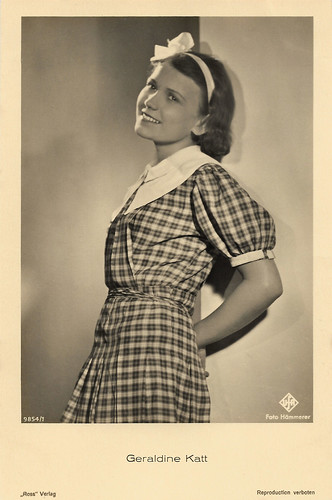
German postcard by Ross Verlag, no. 9854/1, 1935-1936. Photo: Hämmerer / Ufa.
Geraldine Katt (1920-1995) was an Austrian actress, who was seen in romantic comedies and melodramas of the 1930s and 1940s. She appeared in more than ten films from 1936 to 1951.

German postcard by Ross Verlag, no. A 1014/1, 1937-1938. Photo: Hämmerer / Ufa. Marlene Pilaete writes to us that the mention “UFA Hämmerer” on the Rochelle Hudson card is probably a printing mistake. Small Ross cards of her from the same session have the Fox logo.
American film actress Rochelle Hudson (1916–1972) appeared in Hollywood films from the early 1930s through the 1960s. Her roles went from ingenue to leading lady to character actress. She is best remembered for co-starring in the tense and gripping social drama Wild Boys of the Road (William A. Wellman, 1933), playing Cosette in Les Misérables (Richard Boleslawski, 1935), as the older sister of Shirley Temple in Curly Top (Irving Cummings, 1935), and as Natalie Wood's mother in Rebel Without a Cause (Nicholas Ray, 1955).

German postcard by Ross Verlag, no. A 1285/1, 1937-1938. Photo: Hämmerer / Ufa.
German actress Karin Hardt (1910-1992) made her cinema debut as a pure and disarmingly natural backfisch, looking for happiness. Her impressive career with many film, theatre and television appearances lasted for six decades.

German postcard by Ross Verlag, no. A 1520/2, 1937-1938. Photo: Ufa / Hämmerer. Hansi Knoteck in Gewitter im Mai/Storms in May (Hans Deppe, 1938).
Austrian singer, stage, and film actress Hansi Knoteck (1914-2013) starred in 18 films in just five years - between 1934 and 1939. She often played the natural, sweet Dirndl in Heimatfilms. She continued her film and stage career until the mid-1970s.

German postcard by Ross Verlag, no. A 1656/1, 1938-1939. Photo: Ufa / Hämmerer.
Gusti Huber (1914-1993) was an Austrian stage and film actress. She was a popular actress in the cinema of Nazi Germany. In 1946 she moved with her American husband to the US and continued her career on Broadway. She played Anne Frank's mother in the Pulitzer Prize-winning play 'The Diary of Anne Frank' and later also in the film version.

German postcard by Ross Verlag, no. A 1899/1, 1937-1938. Photo: Ufa / Hämmerer.
Charismatic German theatre and film actress Brigitte Horney (1911-1988) worked both in German and English films. Her earthy charm, prominent cheekbones and deep, sultry voice made her stand out from her colleagues. She is best remembered as Empress Katherine the Great in the lavish Ufa spectacle Munchhausen/The Adventures of Baron Munchausen (1943). After the war, she moved to the US and became an American citizen.

German postcard by Ross Verlag, no. A 2110/1, 1939-1940. Photo: Hämmerer / Ufa. Gustl Stark-Gstettenbaur in Der Edelweißkönig/King of the Edelweiss (Paul May, 1939).
German stage, film, and television actor Gustl Stark-Gstettenbaur (1914-1996) or Gustl (Stark-)Gstettenbauer began his career onstage as a child actor in 1927, at the age of thirteen. He went on to play a variety of juvenile roles in German films during the late silent film era. Gstettenbaur's career continued as an adult on stage, in film, and on television.

German postcard by Ross Verlag, no. A 3337/1, 1941-1944. Photo: Hämmerer / Wien Film.
Actor Paul Hörbiger (1894-1981) belongs together with Hans Moser to the ‘primary rock’ of the Austrian cinema. His popularity was unique and was reflected in over 200 films.
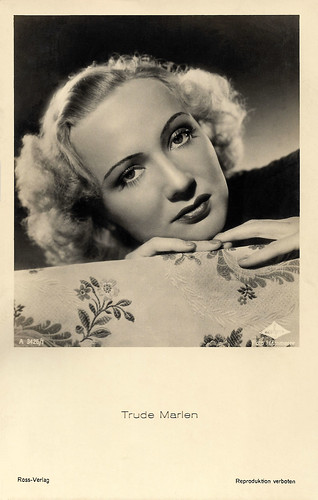
German postcard by Ross Verlag, no. A 3426/1, 1941-1944. Photo: Wien-Film / Hämmerer.
Trude Marlen (1912-2005), was a curly-locked Austrian leading lady of the 1930s. From 1933 until the 1940s, she made mostly light entertainment films as a Ufa star, in which Willi Forst was often her partner. The Ufa traded her as the German answer to Jean Harlow, but for the most part, she was rather the Viennese equivalent of the 'girl next door', engaging and uncomplicated.
Ross Verlag Film Grossbilder
In 1936 and 1937, Ross made a series of "Film Grossbilder", big black and white cards with size 5 1/4" x 7" or 13 x 18 cm. Ross published the cards for the Union Cigarettenfabrik (Union Cigarette Factory). This series of large cigarette cards was available to those who purchased Romana cigarettes.

Big German card by Ross Verlag. Photo: Ufa / Hämmerer.
German actress Evi Eva (1899-1985) was a popular star of silent cinema. She often impersonated 'Berliner Gören' or 'Backfische' (brats) in film comedies. Later, the once-famous actress lived in very poor conditions.
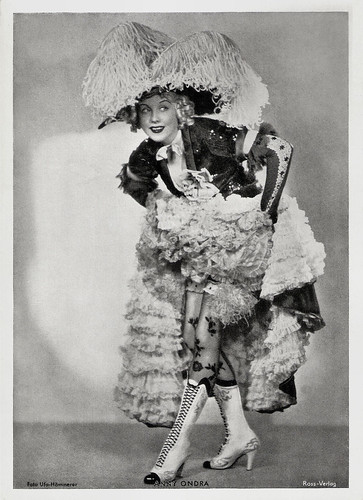
Big German collectors card by Ross Verlag. Photo: Ufa / Hämmerer. Anny Ondra in Ein Mädel von Ballett/A Girl from the Chorus (Karel Lamac, 1937).
Anny Ondra (1903-1987) was a Polish-Czech-Austrian-German-French singer, film, and stage actress. During the 1920s and 1930s, she was a popular actress in Czech, Austrian and German comedies, and she was Alfred Hitchcock’s first ‘Blonde’.
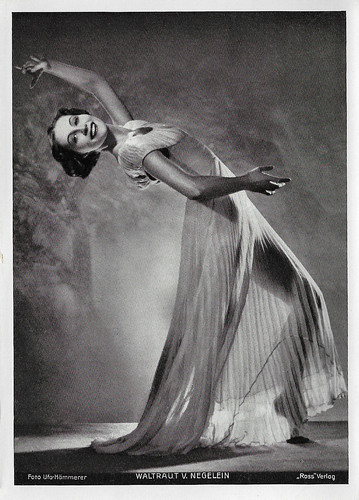
Big German card by Ross Verlag. Photo: Hämmerer / Ufa.
Waltraut von Negelein appeared in only two films, Daphne und der Diplomat/Daphne and the Diplomat (Robert A. Stemmle, 1937) with Karin Hardt, and the Western Frauen für Golden Hill/Women for Golden Hill (Erich Waschneck, 1938) with Kirsten Heiberg.

Big German card by Ross Verlag. Photo: Ufa / Hämmerer. Publicity still for Frauen für Golden Hill/Women for Golden Hill (Erich Waschneck, 1938).
Grethe Weiser (1903-1970) was a German singer, comedian, film and stage actress. She made more than 140 films.
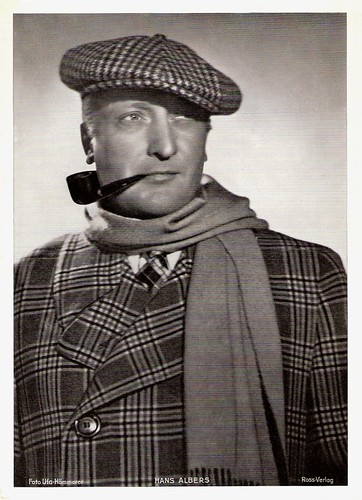
Big card by Ross Verlag. Photo: Ufa / Hämmerer. Hans Albers in Der Mann, der Sherlock Holmes war/The Man Who Was Sherlock Holmes (Karl Hartl, 1937).
Jovial, pleasantly plump Hans Albers (1891–1960) was a superstar of German cinema between 1930 and 1945. He was also one of the most popular German singers of the twentieth century. His song 'Auf der Reeperbahn nachts um halb eins' (On the Reeperbahn at half past midnight) is the unofficial anthem of Hamburg’s neighbourhood of St. Pauli, which is famous for its brothels, music and nightclubs.
Film Foto-Verlag
Ross Verlag seemed to disappear by the end of the war. The National Socialists had retained the name after they had forced Heinrich Ross out of his own company. But during the Second World War, they also started to use the name Film-Foto-Verlag. The design of the cards and the numbering system did not alter. Hämmerer's photos for Wien-Film also found their way to the postcards of this publisher.
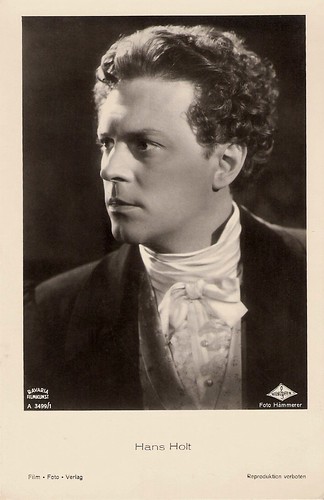
German postcard by Film-Foto-Verlag, no. A 3499/1, 1941-1944. Photo: Hämmerer / Wien-Film / Bavaria Filmkunst. Hans Holt in Brüderlein fein/Little brother fine (Hans Thimig, 1942).
Austrian actor Hans Holt (1909-2001) appeared in nearly 100 films in a career that stretched back to 1935. He portrayed Baron Von Trapp in two German films from the 1950s, a role which Christopher Plummer later played in the musical The Sound of Music.

German postcard by Film-Foto-Verlag, no. A 3500/1, 1941-1944. Photo: Hämmerer / Wien Film.
Austrian actress Maria Holst (1917-1980) appeared in many plays of the famous Viennese Burgtheater and also in several popular films of the 1930s, 1940s and 1950s. She died tragically.

German postcard by Film-Foto-Verlag, no. A 3558/1, 1941-1944. Photo: Hämmerer / Wien-Film.
Blonde Winnie Markus (1921-2002) started as a Ufa star during the Nazi period and became one of Germany’s most famous actresses in the 1950s.

German postcard by Film-Foto-Verlag, no. A 3763/1, 1941-1944. Photo: Wien-Film / Hämmerer.
Austrian actor O.W. Fischer (1915–2004) was one of the most popular and highest-paid actors in German-language films in the 1950s. He played the lead in dozens of light romantic comedies and historical pieces. Unlike countrymen Curd Jürgens, Maria Schell and Romy Schneider, he never made it internationally.

German postcard by Film-Foto-Verlag, no. A 3765/2, 1941-1944. Photo: Hämmerer / Wien-Film.
Austrian actress Marte Harell (1907-1996) played strong women who determined the events, in several Viennese comedies and operettas of the 1940s and 1950s.
Various publishers
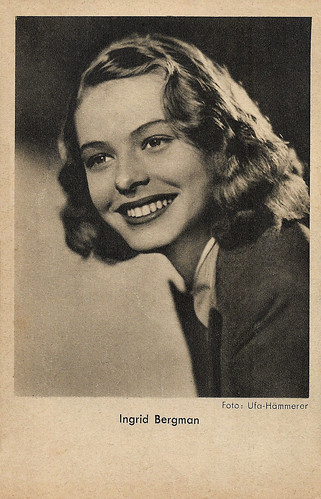
German postcard. Photo: Ufa / Hämmerer. Ingrid Bergman in Die vier Gesellen/The Four Companions (Carl Froelich, 1938).
Ingrid Bergman (1915-1982) was ‘Sweden's illustrious gift to Hollywood’. In the 1940s the fresh and naturally beautiful actress won three times the Oscar, twice the Emmy, and once the Tony Award for Best Actress. Little known is that before she went to Hollywood she already had a European film career.

German postcard by Das Programm von Heute / Ross Verlag, Berlin. Photo: Wien-Film / Hämmerer.
Austrian actor Hans Moser (1880-1964) appeared in over 150 films. During his long career, from the 1920s up to his death, he became very popular as the mumbling factotum in comedy films. Moser was particularly associated with the genre of the Wiener Film.

Austrian postcard by Verlag Hubmann, Wien (Vienna), no. 3323. Photo: Hämmerer, Wien.
Tall, blonde, blue-eyed Curd Jürgens (1915-1982) played German soldiers in countless World War II films, usually billed as Curt Jurgens. Although the German-Austrian actor appeared in over 100 films, Jürgens considered himself primarily a stage actor. He also directed a few films with limited success and wrote screenplays.

Austrian postcard by Schreiber-Karte, no. 70087. Photo: Hämmerer / Wien-Film.
Austrian film and stage actress Angelika Hauff (1922–1983) played the lead in several post-war German and Austrian films. For the East-German DEFA studio, she appeared in three films, including the box office hit Figaros Hochzeit/The Marriage of Figaro (1949).

German postcard by Ufa/Film-Foto, Berlin-Tempelhof, no. FK 3875. Photo: Hämmerer / Vienna / Schorcht Film. Publicity still for Skandal in Ischl/Scandal in Bad Ischl (Rolf Thiele, 1957).
German actor Michael Ande (1944) was a well-known child star of German cinema during the 1950s. Nowadays he is best known for his role in the West German Krimi TV series Der Alte/The Old Fox (1977-2016).
Sources: Peter Ernst (German - Unse Kienwerder), Filmportal, and IMDb.
No comments:
Post a Comment